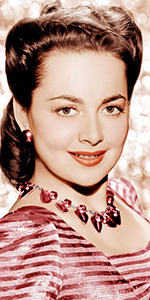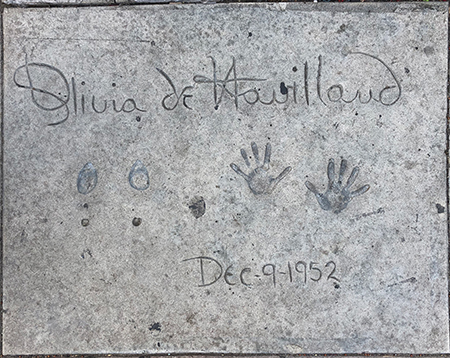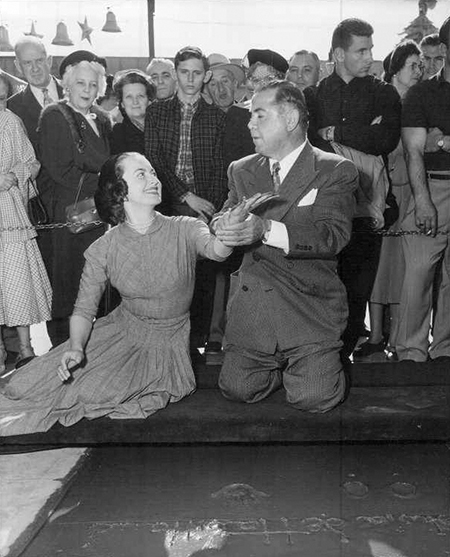 |
 |
 |
 |
 |
| Olivia de Havilland, date unknown. |
| |
|
 |
|
 |
| |
| |
| |
| |
| |
| |
|
|
| Olivia de Havilland |
 |
| Forecourt Ceremony held on Tuesday, December 9, 1952 |
| |
Born: July 1, 1916, in Tokyo, Japan
Age at the time of the ceremony: 36
Died: July 26, 2020, in Paris, France, aged 104 |
| |
Olivia de Havilland was an actress of exceptional range and talent, with a winning personality and elegance, with plenty of firepower when needed. She was one of the biggest names in Hollywood during the Golden Age.
Born to British parents working in Tokyo Japan, Olivia's mother had been an actress on the stage. The couple separated in 1919. Worried for younger daughter Joan's health, Lillian moved her and older daughter Olivia to Saratoga California, where Joan's health improved. Olivia and Joan began taking acting and diction lessons, elocution, Shakespeare — Olivia was a good student.
Attending Los Gatos High School where Olivia excelled in oratory and field hockey, she participated in school plays. Upon graduation, she wanted to become an English teacher; she attended the Notre Dame Convent in Belmont California.
Appearing as Alice in a 1933 local production of Alice in Wonderland put Olivia on a collision course with her stepfather, who refused to allow Olivia to play the lead in a production of Pride and Prejudice; Oliva left home in order to do the play. Graduating college in 1935, Olivia perfomed as Puck in A Midsummer Night's Dream in Saratoga, where she was seen by an assitant to Max Reinhardt; she found herself as second understudy to Hermia in Reinhardt's famous production at the Hollywood Bowl.
After Gloria Stuart backed out, and the first understudy did so also, de Havilland stepped into the role with only one week of rehearsal. De Havilland so impressed Reinhardt that she toured in the show; when he was asked to make a film of Dream for Warner Bros., Reinhardt asked her to play Hernina. Still wanting to be a teacher, she signed a five-year contract with the studio.
While attracting much notice, Dream was a box-office disappointment. De Havilland and her mother saw her appearing in blasé films at the Warner studio. But in 1935, Warners' took a chance on giving de Havilland and newcomer Errol Flynn the leads in their swashbuckler Captain Blood (released in December 1935), whcih became a huge hit. She was next paired with Fredric March in Anthony Adverse (released in August 1936).
Being reunited with Flynn in The Charge of the LIght Brigade (released in October 1936), resulted in another hit, allowing de Havilland to re-negotiate her contract. She recieved top billing in the comedy Call It a Day (released in April1937), but third-billing in It's Love I'm After (released in November 1937), and second-billing in The Great Garrick (released in October 1937).
Historical pictures seemed to be where de Havilland shone best: Gold is Where You Find It (released in February 1938), followed by her appearance as Maid Marion with Errol Flynn in the title role of The Adventures of Robin Hood (released in May 1938), which became a world-wide smash hit. This was followed by appearing with Flynn again in the western, Dodge City (released in April 1939), which became yet another hit film.
Co-starring with Flynn and Bette Davis in The Private Lives of Elizabeth and Essex (released in November 1939) as well as Raffles (released in December 1939), proved to be let-downs, but de Havilland roared back.
Producer David O. Selznick wanted de Havilland to play the role of Melanie in his film of Gone with the Wind (released in December 1939), but Warner Bros. head Jack Warner wouldn't allow it. Olivia simply consorted with Warner's wife Anne, who convinced her husband to allow Olivia to take the part. And what a part. De Havilland gives a truly amazing performance in this film, holding the whole thing together in a way.
Co-starring again with Errol Flynn, de Havilland had another great success with Santa Fe Trail (released in December 1940) with Ronald Reagan in the cast.
After a bout with appendicitis, de Havilland became somewhat choosy about her roles, taking on The Strawberry Blonde (in February 1941) with James Cagney, and Hold Back the Dawn (released in September 1941) with Charles Boyer at Paramount, the studio which she gravitated toward in the next few years.
But before that could happen, she and Flynn did their last film together, They Died with Their Boots On (released in January 1942), and In This Our Life (released in May 1942) with Bette Davis again. De Havilland enjoyed making Princess O'Rourke (released in October 1943) with Robert Cummings, but by now, she discovered that, by refusing projects, time was added onto her Warner contract. Instead of being free to work elsewhere, Warners' claimed she owned them six more months of work. She sued them and won her freedom, but was effectively blacklisted for two years.
During the War years, de Havilland toured the country selling War Bonds, working at the Hollywood Canteen, and touring the Pacific theatre.
Afterwards, her first picture for Paramount was To Each His Own (released in March 1946) which brought de Havilland her first Oscar for Best Actress.
It was followed by the noir The Dark Mirror (released in October 1946). Switching over to 20th Century-Fox, de Havilland went way out on a limb and appeared in The Snake Pit (which played the Chinese in December 1948).
She teamed up with director William Wyler for The Heiress (released in December 1949), for which she received her second Oscar for Best Actress.
She mounted a production of Romeo and Juliet on Broadway in 1952, and toured the country with it.
Marrying Paris Match editor Pierre Galante in 1955 allowed de Havilland to make films abroad: That Lady (released in May 1955), Not as a Stranger (released in July 1955), and The Ambassador's Daughter (released in July 1956), but none of these films were successful.
More successful was the western The Proud Rebel (releaseed in May 1958) with Alan Ladd, as well as Light in the Piazza (released in February 1962). She performed with Henry Fonda in the play A Gift oif Time on Broadway in 1962. That same year, she published her memior, Every Frenchman Has One.
Back in Hollywood, de Havilland did the films Lady in a Cage (released in June 1964), and Hush. . . Hush, Sweet Charlotte (released in December 1964) with Bette Davis. She also dabbled in television: the movie The Screaming Woman (1972), Roots: the Next Generations (1979), Murder is Easy (1982), The Royal Romance of Charles and Diana (1982), Anastasia: The Mystery of Anna (1986), and finally, The Woman He Loved (1988). She narrated the documentary I Remember Better When I Paint (released in 2009).
Olivia de Havilland retired from the screen and lived in Paris, France until her death at the age of 104.
|
|
|
|
|
| |
 |
 |
| Grauman's Chinese Theatre, Hollywood, California. Olivia de Havilland Forecourt Block. Executed by Jean Klossner, Tuesday, December 9, 1952. 49 x 39 inches. |
 |
 |
 |
| Grauman's Chinese Theatre, Hollywood, California. Olivia de Havilland Forecort ceremony, Tuesday, December 9, 1952. Olivia de Havilland holds her cement-slathered hand out for inspection by Charles Skouras, president of Fox West Coast Theatres. |
|
 |
|